In the realm of modern living, tiny homes have emerged as a captivating trend, offering a unique blend of comfort, sustainability, and affordability. However, as with any substantial investment, safeguarding your tiny home against unforeseen events is crucial. Enter tiny home insurance, a specialized coverage designed to protect your compact abode and its contents.
This comprehensive guide delves into the intricacies of tiny home insurance, providing valuable tips and insights to ensure you make informed decisions and secure the best coverage for your tiny home.
With its compact size and unique features, tiny homes present distinct insurance considerations compared to traditional dwellings. Understanding these nuances is paramount in selecting the appropriate coverage. From assessing your specific needs and evaluating policy options to navigating the claims process and maintaining coverage, this guide equips you with the knowledge and strategies to protect your tiny home investment effectively.
Getting to Know Tiny Home Insurance Coverage

Tiny homes, with their growing popularity, require specialized insurance coverage tailored to their unique characteristics. This coverage is designed to protect the structure, contents, and occupants of a tiny home from various risks and liabilities.
Tiny homes face potential risks and liabilities similar to traditional homes, such as fire, theft, and natural disasters. However, due to their size and mobility, tiny homes may face additional risks, such as being more susceptible to damage during transportation or while parked in different locations.
Common Tiny Home Insurance Policies
Tiny home insurance policies typically cover the following:
- Structure: The physical structure of the tiny home, including its walls, roof, and foundation.
- Contents: Personal belongings and items inside the tiny home, such as furniture, appliances, and electronics.
- Liability: Protection against legal claims resulting from injuries or property damage caused by the tiny home or its occupants.
- Additional Living Expenses: Coverage for temporary living expenses if the tiny home becomes uninhabitable due to a covered loss.
Understanding the Insurance Policy
Tiny home insurance policies come in various forms, each offering a unique set of coverage options. It’s essential to select a policy that aligns with your specific needs and circumstances. The standard components of a tiny home insurance policy typically include:
Coverage for the Structure
- Dwelling coverage: Protects the physical structure of your tiny home, including its interior and exterior features.
- Other structures coverage: Covers detached structures on your property, such as sheds, garages, or carports.
- Personal property coverage: Protects your belongings inside the tiny home, including furniture, appliances, electronics, and clothing.
Liability Coverage
- Personal liability coverage: Protects you against claims of bodily injury or property damage caused to others on your property.
- Medical payments coverage: Covers medical expenses for guests who are injured on your property, regardless of fault.
Additional Coverage Options
- Loss of use coverage: Reimburses you for additional living expenses if you’re unable to live in your tiny home due to a covered loss.
- Replacement cost coverage: Pays to replace your tiny home or personal belongings with new items of similar quality and value.
- Scheduled personal property coverage: Provides additional coverage for high-value items, such as jewelry, artwork, or electronics.
Carefully reviewing and understanding the terms and conditions of your tiny home insurance policy is crucial. This includes being aware of the policy limits, deductibles, exclusions, and any special endorsements or riders that may apply. By thoroughly understanding your policy, you can ensure that you have adequate coverage in the event of a covered loss.
Assessing Your Coverage Needs
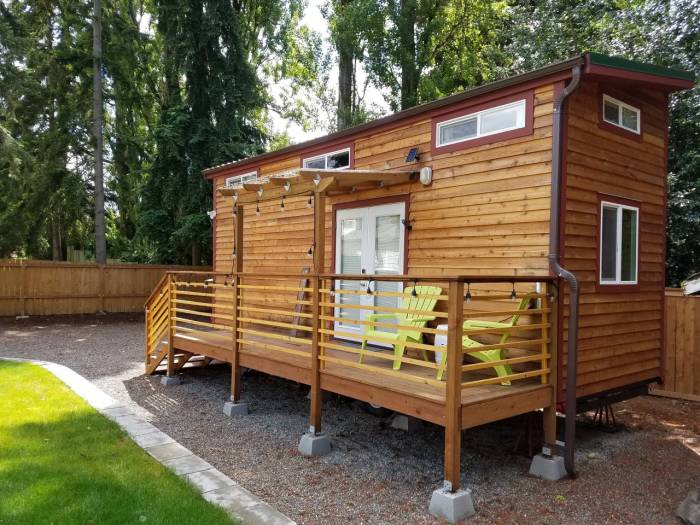
Before obtaining tiny home insurance, carefully evaluate your specific coverage requirements. Determine the appropriate amount of coverage for your tiny home, personal property, and liability risks. Consider the following factors:
Value of Your Tiny Home
Estimate the current market value of your tiny home, including any recent upgrades or renovations. This value will serve as the basis for determining the appropriate level of dwelling coverage.
Personal Property Coverage
Assess the value of your personal belongings, including furniture, appliances, electronics, and clothing. Consider purchasing additional coverage for valuable items such as jewelry, artwork, or collectibles.
Liability Coverage
Evaluate your potential liability risks, such as injuries sustained by guests or damage to their property while on your tiny home premises. Determine an appropriate amount of liability coverage to protect yourself financially in case of such incidents.
Additional Considerations
Think about any unique features or add-ons to your tiny home that may require specialized coverage, such as solar panels, decks, or outdoor structures. Additionally, consider any potential risks associated with the location of your tiny home, such as proximity to natural hazards or high-crime areas.
Shopping for Tiny Home Insurance
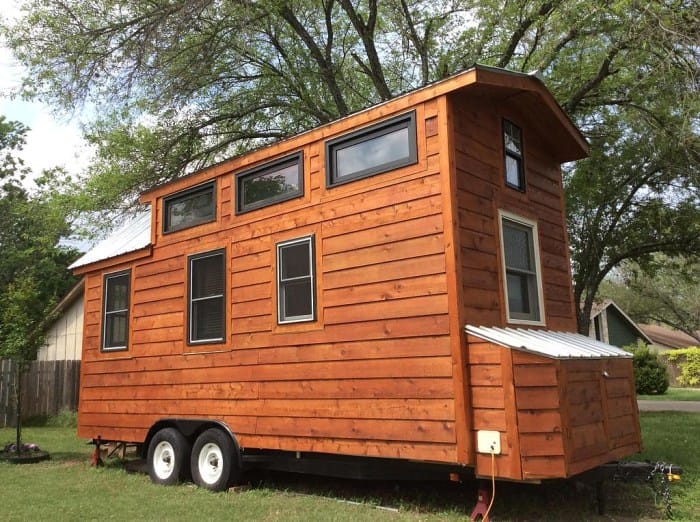
Selecting the most suitable tiny home insurance coverage requires careful comparison and evaluation. Comparing quotes from multiple providers is essential to secure the best coverage at a reasonable price.
When comparing tiny home insurance quotes, consider the following factors:
Reputation and Financial Stability of Insurance Companies
Before purchasing insurance, it is crucial to assess the reputation and financial stability of the insurance company. A reputable and financially stable company is more likely to provide reliable coverage and prompt claim settlements.
- Research the company’s financial ratings from independent agencies like A.M. Best or Standard & Poor’s.
- Read customer reviews and feedback to understand the company’s service quality and claim settlement history.
Obtaining Quotes and Comparing Coverage Options
To obtain quotes and compare coverage options, consider the following steps:
- Contact multiple insurance providers directly or through an insurance agent.
- Provide accurate and detailed information about your tiny home, including its size, construction materials, location, and personal belongings.
- Request quotes for various coverage options, including dwelling coverage, personal property coverage, and liability coverage.
- Compare the quotes side-by-side, considering the coverage limits, deductibles, and premium costs.
Making a Claim
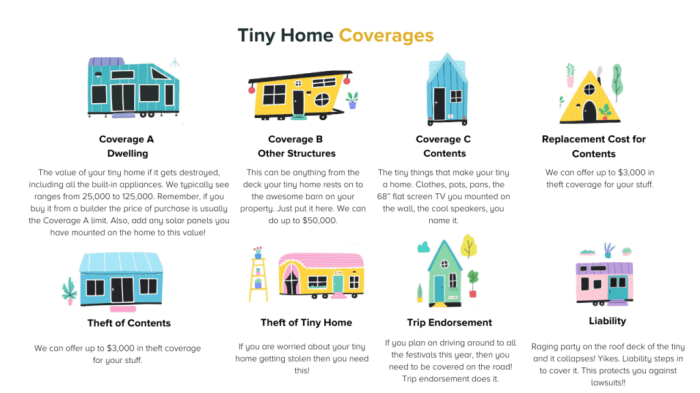
When the unforeseen occurs, knowing the steps involved in filing a claim under your tiny home insurance policy is crucial. It ensures a smooth process and timely assistance during a stressful time.
Filing a Claim
1. Contact Your Insurance Provider
Promptly notify your insurance provider about the incident or loss. Contact information is typically found on your policy documents or the insurer’s website.
2. Provide Initial Details
Be prepared to provide basic information, including your policy number, the date and location of the incident, a brief description of the damage or loss, and contact details.
3. Document the Incident
Thoroughly document the incident by taking photographs or videos of the damage, retaining receipts for any expenses incurred due to the incident, and keeping a detailed record of conversations with your insurance provider.
4. Submit a Formal Claim
Your insurance provider will likely provide a claim form that you must complete and submit along with supporting documentation. Ensure you provide accurate and comprehensive information to expedite the claims process.
Claims Settlement Process
1. Assessment of Damages
An insurance adjuster will be assigned to assess the damage or loss. They will inspect the property, review the claim form and supporting documentation, and determine the extent of coverage.
2. Settlement Offer
Based on the assessment, the insurance provider will present a settlement offer, which is the amount they are willing to pay for the covered damages or losses.
3. Negotiation
If you believe the settlement offer is inadequate, you can negotiate with the insurance provider for a higher settlement amount. This process may involve providing additional documentation or engaging an attorney.
4. Payment
Once the settlement amount is agreed upon, the insurance provider will issue payment, either directly to you or to the contractor performing the repairs or replacements.
Potential Challenges
1. Policy Exclusions
Be aware of exclusions in your insurance policy that may limit or void coverage for certain types of damages or losses. Carefully review your policy to understand what is and isn’t covered.
2. Underinsurance
Ensure you have adequate insurance coverage to fully protect your tiny home and belongings. Underinsurance can result in insufficient funds to cover the actual cost of damages or losses.
3. Delays
The claims settlement process can sometimes be lengthy, especially for complex or disputed claims. Be prepared for potential delays and have patience throughout the process.
4. Disputes
In the event of a disagreement with the insurance provider regarding the settlement offer or coverage, you may need to file an appeal or pursue legal action.
Maintaining Your Coverage
Sustaining proper documentation and records is vital for maintaining coverage under your tiny home insurance policy. Keep organized files of essential paperwork, including the policy document, declarations page, endorsements, and any correspondence with your insurer. These records serve as proof of coverage and assist in processing claims efficiently.
To ensure your policy remains up-to-date, promptly notify your insurer of any changes that may affect coverage, such as renovations, additions, or changes in personal property value. Review your policy annually to assess if coverage limits still align with your needs and consider increasing coverage if necessary.
Additionally, maintain regular communication with your insurer to stay informed about policy changes or updates.
Consequences of Inadequate Coverage
Neglecting to maintain adequate coverage can have severe repercussions. If your tiny home sustains damage or loss exceeding your policy limits, you may be responsible for the remaining costs. This financial burden can be substantial, potentially leading to financial hardship.
Moreover, inadequate coverage may jeopardize your ability to obtain a loan or mortgage, as lenders often require proof of sufficient insurance.
Additional Considerations
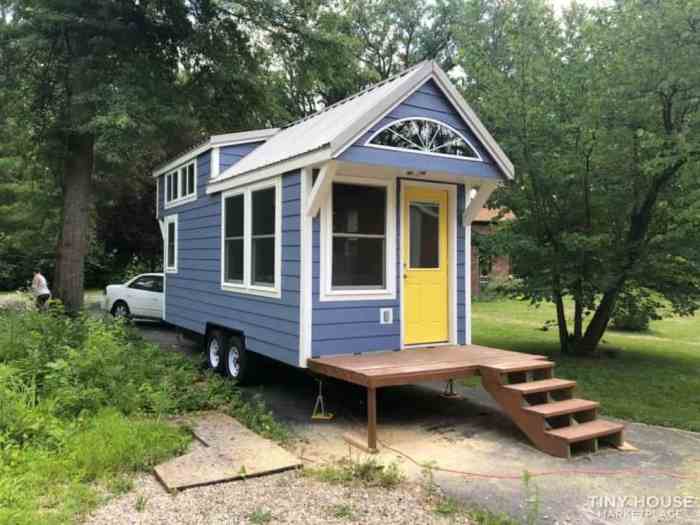
Tiny homes present unique insurance considerations due to their size, mobility, and potential location in high-risk areas. Understanding these considerations can help ensure adequate coverage for your tiny home.
Unique Considerations for Tiny Homes in Specific Locations:
- Remote or Rural Areas: Tiny homes in remote or rural areas may have limited access to emergency services and may be more susceptible to natural disasters. Consider additional coverage for natural disasters common in the area.
- Coastal Areas: Tiny homes near the coast face risks such as hurricanes, flooding, and storm surges. Ensure your insurance policy covers these perils and consider additional flood insurance if necessary.
- Earthquake-Prone Areas: Tiny homes in earthquake-prone areas should have coverage for earthquake damage. Consider seismic retrofitting to strengthen the structure and reduce the risk of damage.
Insuring Tiny Homes as Vacation Homes or Rentals:
If you plan to use your tiny home as a vacation home or rental property, there are specific insurance considerations:
- Liability Coverage: Ensure your policy includes liability coverage to protect you from legal claims arising from accidents or injuries on your property.
- Renter’s Insurance: If you’re renting out your tiny home, consider renter’s insurance to cover the belongings of your tenants.
- Loss of Rental Income: If your tiny home is damaged or destroyed, loss of rental income coverage can help compensate for the rental income you would have earned during the repair or rebuilding process.
Impact of Zoning Regulations and Building Codes:
Zoning regulations and building codes may impact your insurance coverage:
- Zoning Restrictions: Some areas may have zoning restrictions that prohibit or limit the placement of tiny homes. Ensure your tiny home complies with local zoning regulations to avoid coverage issues.
- Building Codes: Tiny homes must comply with local building codes to ensure they are safe and habitable. Non-compliance with building codes may void your insurance coverage.
Home Safety and Prevention

Tiny homes may be small, but they still require proper safety and security measures to protect your belongings and ensure the well-being of your family. Taking preventive measures can also help reduce insurance risks and potentially lower your insurance premiums.
Here are some tips for enhancing the safety and security of your tiny home:
Security Features
- Install a security system with motion sensors, cameras, and alarms to deter potential intruders and alert you to any suspicious activity.
- Reinforce doors and windows with sturdy locks, bars, and window films to make them more difficult to break through.
- Consider installing a peephole or video doorbell to identify visitors before opening the door.
- Keep your property well-lit, as dark areas can attract burglars. Install motion-activated lights or solar-powered lights around the perimeter of your home.
Fire Prevention
- Install smoke and carbon monoxide detectors in all sleeping areas and common areas to alert you to potential hazards.
- Keep fire extinguishers within reach in case of emergencies.
- Never leave candles or other open flames unattended.
- Be cautious when using space heaters and ensure they are placed on stable surfaces away from flammable materials.
Water Damage Prevention
- Install a water leak detector to alert you to potential leaks before they cause significant damage.
- Check your plumbing system regularly for leaks and fix them promptly.
- Consider installing a sump pump in areas prone to flooding.
- Maintain your gutters and downspouts to ensure proper drainage away from your home.
By taking these preventive measures, you can reduce the risk of damage to your tiny home and potentially lower your insurance premiums. Additionally, these measures can provide peace of mind and a safer living environment for you and your family.
Comparing Tiny Home Insurance to Traditional Home Insurance
Tiny home insurance and traditional home insurance share some similarities, yet there are key differences to consider when making a decision. This comparison will help you understand the coverage, costs, and policy terms of both types of insurance, enabling you to choose the right coverage for your needs.
Here’s a comprehensive comparison of tiny home insurance and traditional home insurance:
Coverage
- Dwelling Coverage: Both policies cover damage or loss to the physical structure of your home, including walls, roof, foundation, and built-in fixtures.
- Personal Property Coverage: This covers your belongings inside the home, such as furniture, appliances, clothing, and electronics. The coverage limits may differ between policies.
- Liability Coverage: Both policies provide liability protection in case someone is injured on your property or if you accidentally cause damage to someone else’s property.
- Additional Coverages: Tiny home insurance policies may offer additional coverages tailored to tiny homes, such as coverage for custom features, off-grid systems, or specialized equipment.
Costs
Generally, tiny home insurance is less expensive than traditional home insurance due to the smaller size and value of tiny homes. However, the cost of both types of insurance can vary depending on factors like the location, age, and construction of the home, as well as the level of coverage and deductible chosen.
Policy Terms
The policy terms for tiny home insurance and traditional home insurance are generally similar. Both types of policies typically have a one-year term and can be renewed annually. However, some tiny home insurance policies may offer more flexible terms, such as month-to-month or seasonal coverage.
Choosing the Right Insurance
When choosing between tiny home insurance and traditional home insurance, consider the following factors:
- Size and Value of Your Home: If you have a tiny home that is valued at less than $100,000, tiny home insurance may be a more affordable option.
- Your Coverage Needs: Assess your personal property and liability risks to determine the level of coverage you need.
- Location and Risks: Consider the location of your tiny home and the potential risks it faces, such as weather events, crime, or natural disasters.
- Policy Terms and Flexibility: Compare the policy terms and flexibility offered by different insurance providers to find a policy that meets your needs.
Additional Resources and Support
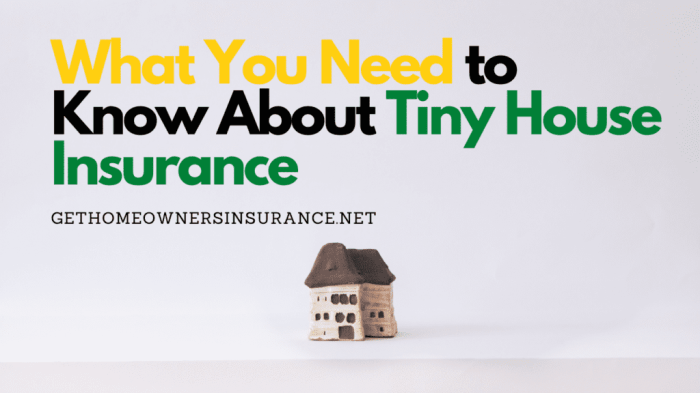
Finding the right insurance policy for your tiny home can be challenging. Several reputable sources offer information and support to help you navigate the process and make informed decisions.
Online Resources
- Tiny House Insurance Association (THIA): THIA is a non-profit organization dedicated to promoting and supporting the tiny house movement. Their website provides a wealth of information on tiny home insurance, including articles, FAQs, and a directory of insurance providers.
- National Tiny House Alliance (NTHA): NTHA is another non-profit organization focused on tiny homes. Their website includes a section on insurance, with links to articles, blog posts, and other resources.
- The Tiny House Society: This online community provides a platform for tiny home owners to connect, share experiences, and access information on various aspects of tiny living, including insurance.
Government Agencies
- Federal Emergency Management Agency (FEMA): FEMA provides information and resources on disaster preparedness and recovery for tiny homes.
- U.S. Department of Housing and Urban Development (HUD): HUD offers programs and resources to support affordable housing, including tiny homes.
- State and Local Governments: Many state and local governments have regulations and requirements related to tiny homes. Check with your local authorities for specific information in your area.
Online Forums and Support Groups
- Tiny House Forums: Several online forums are dedicated to tiny home living, where you can connect with other tiny home owners and discuss various topics, including insurance.
- Social Media Groups: There are numerous social media groups focused on tiny homes, where you can ask questions, share experiences, and learn from others.
- Tiny House Meetups: Local meetups and events provide opportunities to network with other tiny home enthusiasts and learn more about insurance and other aspects of tiny living.
Conclusion

The journey of tiny homeownership is an exciting adventure, and securing the right insurance coverage is an essential step in safeguarding your investment. By following the tips and guidance provided in this comprehensive guide, you can navigate the complexities of tiny home insurance with confidence.
Remember, the key lies in understanding your unique needs, evaluating policy options thoroughly, and maintaining proper documentation. With the right coverage in place, you can rest assured that your tiny home, a symbol of sustainable living and personal expression, is well-protected against unforeseen circumstances.
FAQ Corner
Q: What unique considerations should I keep in mind when insuring my tiny home?
A: Tiny homes often face unique challenges, such as zoning regulations, building codes, and potential risks associated with their compact size. It’s essential to discuss these factors with your insurance provider to ensure adequate coverage.
Q: How can I assess my tiny home insurance coverage needs accurately?
A: To determine the appropriate coverage amount, consider factors like the value of your tiny home, personal property, and potential liability risks. Carefully evaluate your specific needs and consult with an insurance professional for personalized advice.
Q: What steps should I take to file a claim under my tiny home insurance policy?
A: In the event of a covered loss, promptly notify your insurance company and provide detailed documentation, including photos, receipts, and a comprehensive list of damaged items. Cooperate with the claims adjuster throughout the process to ensure a smooth settlement.
Q: How can I maintain my tiny home insurance coverage effectively?
A: Keep your insurance policy up-to-date by promptly reporting any changes to your tiny home, such as renovations or changes in usage. Maintain proper documentation, including receipts for repairs and maintenance, to support your coverage.
Q: What preventive measures can I take to reduce insurance risks and potentially lower premiums?
A: Implementing home safety features like smoke detectors, security systems, and proper maintenance can help minimize risks and may lead to lower insurance premiums. Consult with your insurance provider to understand specific measures that may qualify for discounts.



